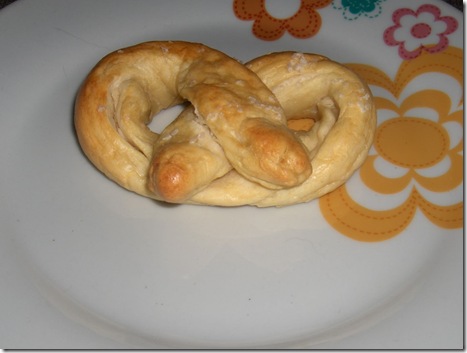
Here’s another of the recipes I made on last night’s In the Kitchen with Cyn. I’ve been making these pretzels since university when my roommate taught me how. This recipe was handed down through her family (she taught me a lot of fabulous German recipes!!!) and we used to go to the cheese shop at the local mall to buy port wine cheese spread to put on them. Delicious! Here's the playback link from last night's show: http://www.linqto.com/PlaybackRoom.aspx?roomname=creativeedventures&name=SingleExplicit_2011_03_08_20_04_06_492
I presented this recipe because Lent is beginning today and these are a Lenten favourite for my family. Why pretzels for Lent? When in the early days of the Catholic Church, the laws for fasting and abstaining from certain foods were much stricter than now…hence the reason for Mardi Gras or “Fat Tuesday”. In some cases, only meat was abstained from – in others, this included fish and all products that “come from meat” such as eggs, milk, and cheese. In other customs, anything considered “decadent” such as sweet foods, things with fats in them, and leavening agents were forbidden during this time.
According to legend, a monk in the 4th century was making some Lenten bread which consisted only of water, flour, and salt. As he was forming these breads, he decided to form the breads into something that could serve as a reminder to his fellow monks that Lent was a time of prayer. So he rolled the dough into strips and then crossed the dough over itself (in the pretzel twist form that we are used to) to simulate the look of a person’s arms folded in prayer (at that time, folding one’s arms over their chest was a very common prayer position). It is said that these breads were called bracellae which is Latin for little arms. In Germany, this became bretzel, which later through time, became pretzel. Another idea for how the word pretzel came about was that a young monk handed the breads out to children as a reward for being able to recite their prayers properly. The Latin word for little reward is pretiola and it is possible the pretzel evolved from this. However the name came about, these breads became very popular during Lent and became known as symbols of good luck, long life, and prosperity. Another legend tells of a young monk who was given the task of making the pretzels. He fell asleep while supposed to be tending the ovens and the pretzels overcooked. At first, his superior was upset that he had ruined the breads but when they tried them, they found that they were still delicious and this is how hard pretzels came about.
I do just a simple pretzel twist but if you'd like to try for a more traditional one, here's a video on how they do it at a New York pretzel shop
Ingredients:
1 pkg. yeast
1/4 cup warm water
1 1/4 cup warm water
4-5 cups flour (I generally find that 4 is just about right but you might just need a little more)
2 tsp. salt
butter
4 tsp. baking soda
kosher or some other kind of large crystal salt
Instructions: Preheat the oven to 475 degrees F. Dissolve the yeast in 1/4 cup of warm water. Add the rest of the water to this mixture once the yeast has dissolved. Mix together 4 cups flour and the 2 tsp.salt. Add the dissolved yeast to the flour and salt and combine to form a stiff dough. Add more flour if needed. Knead this for about 10 minutes until it’s elastic. Form into a ball and coat with butter. Cover with a moist dish towel and place in a warm spot to rise (your oven set to its lowest setting is often a good spot). Let rise for 45 minutes – it will pretty much double in size. Bring a large pot of water (like a stock pot) to boil. While waiting for it to boil. form your pretzels (into the traditional twists or other shapes). Once the water has come to a boil, put the baking soda into it (it may fizz up a bit). Drop pretzels into the water and let them boil until they float to the surface (doesn’t take long so stay close by). Put the coarse salt onto the pretzels (or if you like lots of salt, you can dip the tops of each pretzel into the salt) and place on a cooking sheet (if not using a non-stick sheet you definitely want to butter the sheet – you can even butter it when using non-stick if you’d like that extra bit of buttery flavour). Bake for about 12 minutes. I love them the best when they’re warm out of the oven!

No comments:
Post a Comment